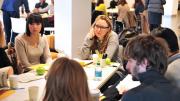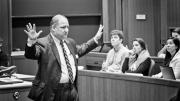Second-year M.B.A. candidates Matt Guilford and Jeremy Schreiber arrived at Harvard Business School back in August 2011 with a lofty goal: merge two seemingly opposite fields—business and design—in a way Harvard had never done before.
“We recognized that many students had a passion for Design Thinking [a process for practical, creative resolution of problems or issues that looks for an improved future result], yet there were no classes or formal training as part of the HBS curriculum,” Schreiber said in an interview with Harvard Magazine. “So we set out to form a club where like-minded individuals could share their passions and learn from each other as well as from industry experts who would give workshops and lectures.”
A year and a half later, their small club (along with the Design Thinking group at the GSD) managed to bring some of the biggest names in business and design—including Charles Adler, founder of Kickstarter; Harry West, CEO of Continuum; and Andy Berndt, vice president of Google Creative Labs—to campus for Harvard’s first university-wide design conference: xDesign.
Throughout the two-day weekend conference, held at the Graduate School of Design (GSD) and Harvard’s i-Lab, designers, graduate students, business professionals, and several hundred other attendees tackled tough questions about twenty-first-century education, watched video presentations on the importance of play in work and life, and packed auditoriums to hear industry experts explain the power of creative thinking.
Although other universities have been exploring the intersection of design and business for several years through programs like the Stanford-based “Innovation Master Series” and “Design Thinking Bootcamp,” xDesign’s organizers said such a conference is new territory for Harvard. “Coming from [HBS dean Nitin Nohria] is a sudden emphasis on design and Design Thinking and the ability to crank out innovative leaders from the Business School, not just analytical thinkers,” said organizer and first-year student Roderick McMullen. “Harvard is really good at a lot of stuff, but I suspect that where they are not good across the board is being the first to do something [in this space].”
The conference began at the GSD on January 25 with a panel discussion, “Design: In and Out,” that included Dean Mohsen Mostafavi, professor of architectural theory and criticism Sanford Kwinter, and professor of Romance languages and literatures Jeffrey Schnapp discussing how different and diverse Design Thinking can be.
On Saturday, the sold-out conference shifted to the business school for a speaker series and a design challenge. Those attending the speaker series heard from industry professionals such as Bill Foulkes, M.B.A ’91, a professor at the Rhode Island School of Design who teaches a class called “Design and Entrepreneurial Thinking.” He described his journey between the design and business worlds and shared ideas on how they complement and frame one another.
Patrick Whitney, dean of the Institute of Design at Illinois Institute of Technology, gave the morning keynote talk. He addressed the ways American business still uses “twentieth-century lenses to try to deal with twenty-first-century problems” and how design can help companies “see through the fog of a chaotic world.” The twentieth century “was about scale and predictability…we’re now moving from that into an age of responsive design,” he said. “We haven’t really started the Third Industrial Revolution yet. What we’re doing is using new machinery to speed up old technology, and we’re only now beginning to get glimpses of what the new offerings will be like.”
Other attendees headed to the i-Lab, where they were split into interdisciplinary teams of eight or 10 and handed a design challenge: “How might we reshape education to meet the needs of twenty-first-century students?” At day’s end, two of the interdisciplinary design groups took the stage at Burden Hall for a live design critique of their work by a panel that included Bruce Nussbaum, professor of innovation and design at Parsons The New School for Design, and Charles Adler, among others. The feedback and commentary was “at times rough and brutal, and yet respectful, honest, and even controversial,” Schreiber reported, calling it “one of the most open and passionate exchanges of ideas I have ever seen at Harvard.”
One team presented their idea of “failure” as an important part of education, proposing the creation of “failure portfolios” in which individuals can track all their successes and mistakes throughout their professional lives. Though many panelists disagreed with this idea of celebrating failure, the overarching point of the exercise, Roderick McMullen said, was achieved.
“It is a new and different thing to do a design critique in front of 250 people [at a business school]—the panelists made sure to show the audience what a real design critique can be like, and it can be brutal,” he explained. “It teaches you that no matter what you do and how good you are, there is always going to be someone who doesn’t like your idea. It also teaches you to divorce your self-esteem from your work. The point [of the critique] was bringing that design culture to the business school.”












